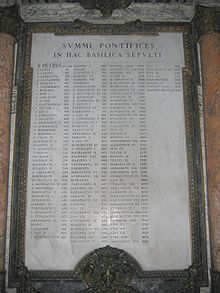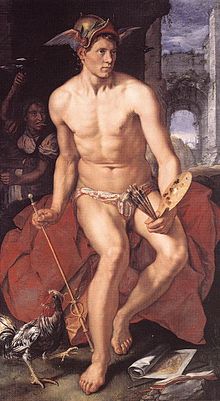- Papal name
-
 Popes buried in St. Peter's
Popes buried in St. Peter's
A papal name is a regnal name taken by popes. Beginning in the sixth century, some popes adopted a new name upon their accession to the papacy; this became customary in the 10th century, and every pope since the 16th century has done so.
Contents
History
During the first centuries of the church, the first bishops of Rome continued to use their baptismal names after their elections. The custom of choosing a new name began in AD 533 with the election of Mercurius.[1] Mercurius had been named after the Roman god Mercury, and decided that it would not be appropriate for a pope to be named after a Roman god. Mercurius subsequently decreed that he would be known as John II. Since the end of the tenth century the pope has customarily chosen a new name for himself during his Pontificate; however, until the 16th century some pontiffs used their baptismal names.
The last pope to use his baptismal name was Pope Marcellus II in 1555, a choice that was even then quite exceptional. The names chosen by popes are not based on any system other than general honorifics. They have been based on immediate predecessors, mentors, political similarity, or even after family members—as was the case with Pope John XXIII.
Some future pope may break with recent practice for symbolic reasons. For example, in the popular film The Shoes of the Fisherman, a Russian Cardinal, Kiril Lakota, announces upon election that "We shall be called by our own name", in honor of the sainted missionary to the Slavic peoples.
In 1978 Cardinal Albino Luciani became the first Pope to take a double name. He took the name John Paul I to honor his two immediate predecessors - Popes John XXIII and Paul VI; he had been elevated to bishop by John XXIII, then to patriarch of Venice and Cardinal by Paul VI. John Paul I was also the first Pope in almost 1,100 years to choose a papal name that wasn't previously used since Pope Lando in 913. After John Paul I died suddenly shortly afterward, Cardinal Karol Józef Wojtyła was elected and, wishing to continue what John Paul I had started, became the second Pope to take a double name when he became John Paul II, as well as the second Pope to be numbered anything less than IV (and the first to be numbered the Second) in almost 430 years since Pope Marcellus II in 1555.
Symbolism
Often the new pontiff's choice of name upon being elected to the papacy is seen as a signal to the world of who the new pope will emulate, what policies he will seek to enact, or even the length of his reign. Such is the case with Benedict XVI - it was speculated that he chose the name because he wished to emulate the last Pope Benedict, and to also call attention to the fact that at 7.5 years that Benedict XV's reign was a relatively short one.
There has never been a Pope Peter II. Even though there is no specific prohibition against doing so, elected Popes have refrained from choosing this name. This is because of a tradition that only Saint Peter should have that honor.
In the 10th century John XIV used the regnal name John because his given name was Peter. While some antipopes did take the name Peter II, their claims are not recognized by the mainstream Roman Catholic Church, and each of these men only either has or had a minuscule following which recognized their claims.
Oddly enough, as of October 2010, global betting pools run by UK bookmakers have converged on Peter as the next Pope's most likely name. This may be related to their predictions that the next Pope will also break precedent by being either a black African or a South American.
Probably because of the controversial Antipope John XXIII, this name was avoided for over 500 years until the election of John XXIII. Immediately after John's election as Pope in 1958, there was some confusion as to whether he would be known as John XXIII or John XXIV. John himself ended the confusion by deciding that he would be known as John XXIII anyway. If possible, the number used by an antipope is ignored.
Current practice
Immediately after a new pope is elected, and accepts the election, he is asked, "By what name shall you be called?" The new Pope chooses the name by which he will be known from that point on. The senior Cardinal Deacon, or Cardinal Protodeacon, then appears on the balcony of Saint Peter's to proclaim the new Pope, informing the world of the man elected Pope, and under which name he would be known during his reign.
(Unless impeded, it is the Dean of the College of Cardinals who asks the newly-elected pope if he accepts his election and what name he will use. In 2005, Cardinal Joseph Ratzinger, himself the Dean, was elected pope, so these questions came from the sub-Dean, Cardinal Angelo Sodano.)
Annuntio vobis gaudium magnum:
Habemus Papam!
Eminentissimum ac Reverendissimum Dominum,
Dominum [forename],
Sanctæ Romanæ Ecclesiæ Cardinalem [surname],
qui sibi nomen imposuit [papal name].I announce to you a great joy:
We have a Pope!
The Most Eminent and Most Reverend Lord,
Lord [forename],
Cardinal of the Holy Roman Church [surname],
who takes to himself the name [papal name].Frequency
# Name # Popes Notes 1. John 21 I · II · III · IV · V · VI · VII · VIII · IX · X · XI · XII · XIII · XIV · XV · XVI · XVII · XVIII · XIX · XX · XXI · XXII · XXIII The last pope of this name was John XXIII; however, John XVI is proclaimed an antipope, while John XX never existed. 2. Gregory 16 I · II · III · IV · V · VI · VII · VIII · IX · X · XI · XII · XIII · XIV · XV · XVI 3. Benedict 15 I · II · III · IV · V · VI · VII · VIII · IX · X · XI · XII · XIII · XIV · XV · XVI The last pope of this name is Benedict XVI; however, Benedict X is proclaimed an antipope. 4. Clement 14 I · II · III · IV · V · VI · VII · VIII · IX · X · XI · XII · XIII · XIV 5. Innocent 13 I · II · III · IV · V · VI · VII · VIII · IX · X · XI · XII · XIII 6. Leo 13 I · II · III · IV · V · VI · VII · VIII · IX · X · XI · XII · XIII 7. Pius 12 I · II · III · IV · V · VI · VII · VIII · IX · X · XI · XII 8. Stephen 9 I · II · III · IV · V · VI · VII · VIII · IX Stephen II succeeded pope-elect Stephen (in some lists marked as Stephen II), who died before he could be consecrated as a bishop and therefore is not included in the official list of popes. 9. Boniface 8 I · II · III · IV · V · VI · VII · VIII · IX The last pope of this name was Boniface IX; however, Boniface VII is proclaimed an antipope. 10. Urban 8 I · II · III · IV · V · VI · VII · VIII 11. Alexander 7 I · II · III · IV · V · VI · VII · VIII The last pope of this name was Alexander VIII; however, Alexander V is proclaimed an antipope. 12. Adrian 6 I · II · III · IV · V · VI 13. Paul 6 I · II · III · IV · V · VI 14. Celestine 5 I · II · III · IV · V 15. Nicholas 5 I · II · III · IV · V 16. Sixtus 5 I · II · III · IV · V 17. Anastasius 4 I · II · III · IV 18. Eugene 4 I · II · III · IV 19. Honorius 4 I · II · III · IV 20. Sergius 4 I · II · III · IV 21. Callixtus 3 I · II · III 22. Felix 3 I · II · III · IV · V The last pope of this name was Felix IV, while Felix II and Felix V are proclaimed antipopes. 23. Julius 3 I · II · III 24. Lucius 3 I · II · III 25. Martin 3 I · II · III · IV · V The last pope of this name was Martin V; however, popes Martin II and Martin III never existed. Marinus I and Marinus II were mistakenly thought to be named "Martin(us)", causing the confusion. 26. Sylvester 3 I · II · III 27. Victor 3 I · II · III 28. Adeodatus 2 I · II 29. Agapetus 2 I · II 30. Damasus 2 I · II 31. Gelasius 2 I · II 32. John Paul 2 I · II 33. Marcellus 2 I · II 34. Marinus 2 I · II 35. Paschal 2 I · II 36. Pelagius 2 I · II 37. Theodore 2 I · II 38. Agatho 1 39. Anacletus 1 40. Anicetus 1 41. Anterus 1 42. Caius 1 43. Conon 1 44. Constantine 1 45. Cornelius 1 46. Dionysius 1 47. Donus 1 48. Eleuterus 1 49. Eusebius 1 50. Eutychian 1 51. Evaristus 1 52. Fabian 1 53. Formosus 1 54. Hilarius 1 55. Hormisdas 1 56. Hyginus 1 57. Lando 1 58. Liberius 1 59. Linus 1 60. Marcellinus 1 61. Mark 1 62. Miltiades 1 63. Peter 1 64. Pontian 1 65. Romanus 1 66. Sabinian 1 67. Severinus 1 68. Silverius 1 69. Simplicius 1 70. Siricius 1 71. Sisinnius 1 72. Soter 1 73. Symmachus 1 74. Telesphorus 1 75. Valentine 1 76. Vigilius 1 77. Vitalian 1 78. Zachary 1 79. Zephyrinus 1 80. Zosimus 1 Notes
- ^ Wrong cited as Pope Adrian III (formerly Agapetus) by McClintock, 1891, p. 82.
- On average the papal name repeats 3.29 times.
- The number of all popes to the present is 263. Pope Benedict IX was elected pope three times, therefore the number of pontificates is actually 265.
- Data are taken from book: A. J. O'Brien, The Popes: Twenty Centuries of History, Libreria Editrice Vaticana, 2002.
References
- McCLintock, John. 1891. Cyclopaedia of Biblical, Theological, and Ecclesiastical Literature. Harper & Brothers. (Available online)
Categories:- Papal names
Wikimedia Foundation. 2010.

